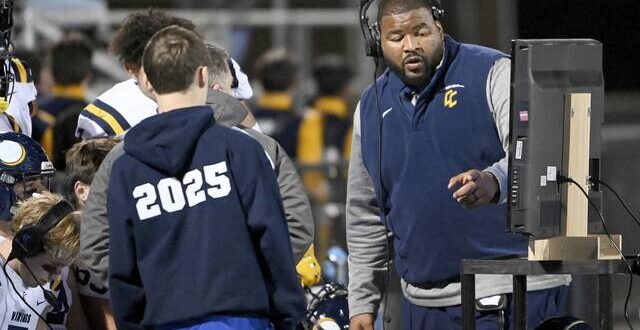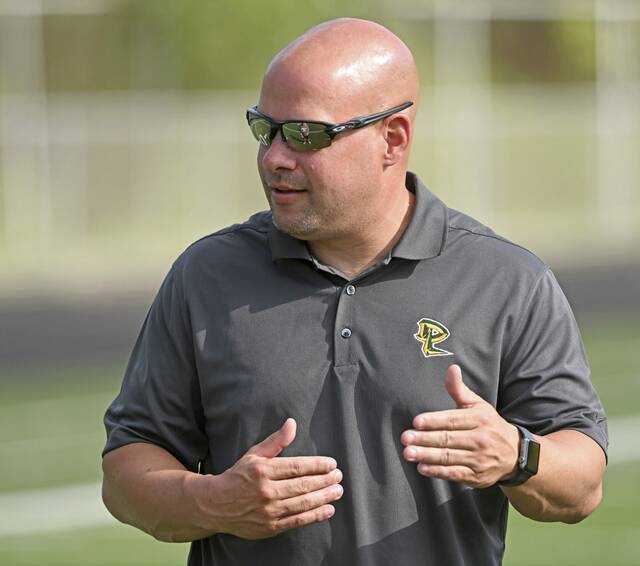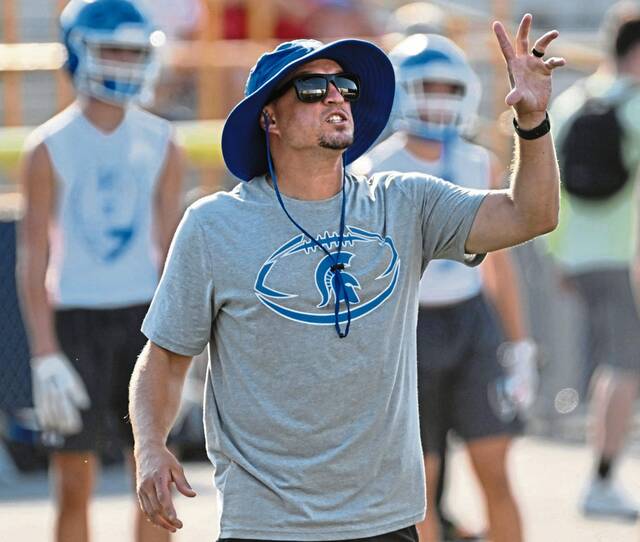By:
Thursday, August 24, 2023 | 5:36 PM
North Allegheny’s Art Walker has coached long enough to remember when filming practice required a bulky camcorder and tapes.
“When I started, it was VHS and then the smaller tapes and then DVDs,” said Walker, who’s entering his 26th season as a head football coach. “Now the video is online and all digital, so it’s forever changing.”
Technologies once available only to NFL or college teams have trickled down to the high school game, much the way spread offenses permeate Friday night playbooks. Nowadays, tablet computers are almost as commonplace on WPIAL sidelines as water coolers.
Many teams will have multiple tablets on the sideline when the regular season begins Friday night, and some have widescreen TVs they can plug into. They’ve become the most obvious sign of the high school football tech boom.
“Before, someone used to gain an edge (by using them),” said Hempfield coach Nick Keefer. “Now you’re just keeping up with everybody at this point.”
The use of tablet computers was first approved before the 2015 season, and they’re now combined with Hudl Sideline or a similar software program that lets coaches and players review previous plays during the game.
Some schools have multiple camera views, including one on a telescoping pole high above the end zone.
“You’re at a disadvantage if you don’t do it,” Keefer said.
At North Allegheny, a quadcopter drone hovers over practices nowadays, piloted by an assistant coach with a cellphone-linked controller, capturing high-resolution video from above.
The PIAA has a policy that bans drones from flying over players or spectators during contests, but they’re free to use on the practice field.
Walker can affectionately be called an old-school coach, but he and his staff of assistants are among those who’ve embraced new-tech ideas.
“I think you have to,” Walker said, “because eventually it’s going to catch up to you.”
Mars coach Eric Kasperowicz first incorporated iPad computers on his sidelines at Pine-Richland in 2015, the year they were allowed under National Federation of State High School Associations (NFHS) rules.
“You’d be stupid not to use them,” he said. “
Every coach the next morning when they’re watching the tape, says, ‘If I would have known that then, I would have called this.’ Well, now you can.”
But the tech innovations didn’t stop there. WPIAL athletes are now wearing biometric monitors, autonomous cameras follow the action at practice, video scoreboards show instant replays and programmable LED stadium lights flash when the home team scores. That’s just to name a few of the changes.
Has the tech revolution benefited the high school game?
Many coaches say yes, crediting the innovations for making communication easier and practices more efficient. They’re also effective tools for engaging a more tech-savvy generation. But these gadgets don’t come cheap, so there’s a definite budget crunch.
“You hate to say that the high school game has turned into the college game, but in terms of fundraising, it kind of has,” Deer Lakes coach Tim Burk said. “You have to find ways to be creative because everything is more expensive, and schools aren’t paying for as much, which is not their fault.
“We’ve been fortunate that we’ve had some people be really supportive and donate significant amounts of money for our program. We’ve been blessed in that aspect.”
Added efficiency
Kasperowicz uses a few electronic gadgets that he says make the Planets’ practices more efficient.
One is a cellphone-sized device with a video screen that members of the scout team wear around their waists. Before each snap, the next play appears on the GoRout screen and details their assignment, eliminating the need for coaches to hold up play cards.
“We’re averaging about 25 seconds between plays versus huddling up, which is probably 45 seconds to a minute between plays,” Kasperowicz said. “You’re getting so many more repetitions.”
GoRout said a typical high school package costs between $1,300 and $2,600 a year.
Mars also purchased ProCom headsets for its coaches to communicate from the sideline to the press box, and they came with a couple of earpieces for players to wear under their helmets. The devices can’t be worn in games, but the quarterback and defensive captain will wear them in practice to ease communication.
“It’s as simple as a coach clicking a button,” Kasperowicz said, “and they can talk to that player during the whole play or whenever he wants.”
The NFHS recently approved catcher-to-coach communication devices in baseball. Kasperowicz said football is next.
“I’d be able to talk on Saturdays,” he said with a laugh. “I wouldn’t have to scream (on Friday nights). I could just whisper in their ear.”
High-tech stadiums
Stadium renovations have become high-tech in the new millennium. As schools replace their aging scoreboards, many new ones come with screens capable of showing live video and sometimes instant replays.
Hempfield renovated its stadium and plans to have its new video scoreboard operating Friday night.
“I’m all about game-day atmosphere,” said Keefer, a first-year coach and one of the youngest at 35. “It’s about giving these kids an experience and having fun and making memories and winning. We have 600 students in our student section. If we have a big play and can put that replay on the board, how much fun is that for everyone involved?”
The lights are also fancier nowadays.
Musco Sports Lighting included an add-on package when it installed LEDs at Gateway’s Antimarino Stadium before last season. When the Gators score a touchdown, the field goes dark, and then the light towers illuminate one at a time, giving the appearance that the light is racing around the stadium.
Hempfield also has those lights.
Tech-savvy generation
This generation of high school football players was born after 2005, so most are about the same age as the original iPhone. They’ve grown up with digital technology, so it’s important for coaches to meet them in their world, Gateway coach Don Holl said.
Holl uses screen-recording software and a video playbook app to send his players game recaps on Saturday and scouting reports each Sunday. The team also communicates through the Hudl messaging app.
“If there’s one thing that’s 100% guaranteed, it’s that they’ve got their phone,” Holl said. “Other than in a meeting or on the practice field, their phone is attached to them.”
Count Deer Lakes among the schools that installed a smart camera that follows the action on the practice field. The Hudl Focus camera can be programmed with a phone app and uploads video to hudl.com. No longer must someone film practice.
“It takes a person out of the mix,” said Burk, a sixth-year coach. “It’s really a great tool, and we’re excited to have it. Anytime during practice you hit the record button right from your phone and it starts recording. It’s pretty slick.”
The camera allows for consistency in the video and minimizes the chance of user error.
“You appreciate all of the volunteers over the years,” Burk said. “But we all lived through the 1980s and ’90s when the VHS recorders came out. How many of our parents were recording the ground and missed the play? That’s the beauty of these things.”
Following NCAA trends
At North Allegheny practices, 10 players are wearing biometric devices made by Catapult that include GPS trackers. The devices are spread around among the position groups to monitor the workload of each.
Those are worn on their backs, under their pads.
“It tracks how much a defensive back or wide receiver is running compared to a lineman,” said Walker, adding that the data is used by their strength and conditioning team. “They’re keeping an eye on that to make sure our guys are fresh and ready.”
Those devices aren’t visible, but the drone buzzing overhead is.
The Tigers record parts of practice with a DJI Mini 2 drone that’s flown by assistant coach Chris Cafardi, a self-described tech nerd. The device weighs less than 9 ounces and cost about $500.
“We’re trying to get things that NCAA and NFL teams have,” Cafardi said, “with a whole lot less resources.”
Chris Harlan is a Tribune-Review Staff Writer. You can contact Chris by email at [email protected] or via Twitter .
 Unmanned Aerial Vehicle The latest drone news
Unmanned Aerial Vehicle The latest drone news






